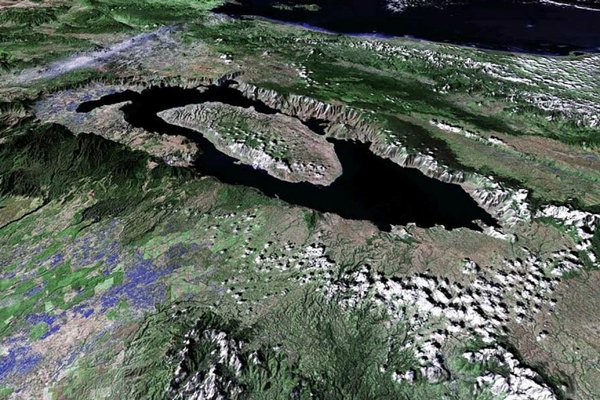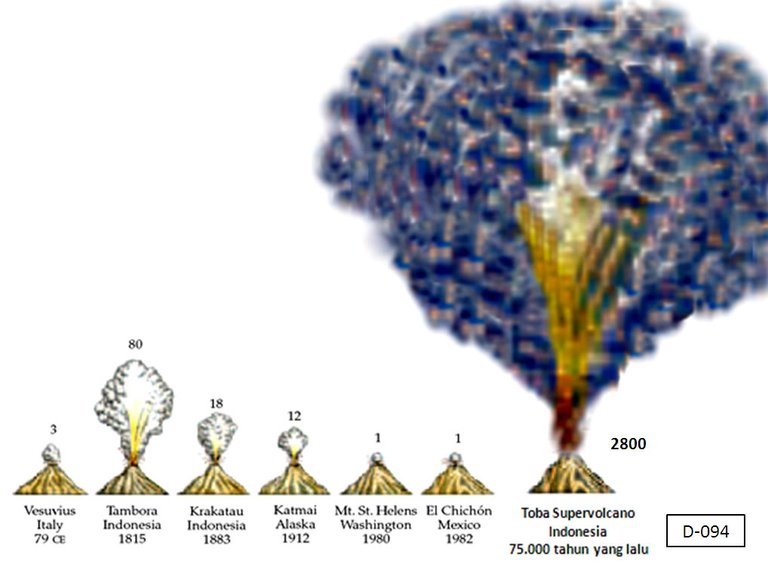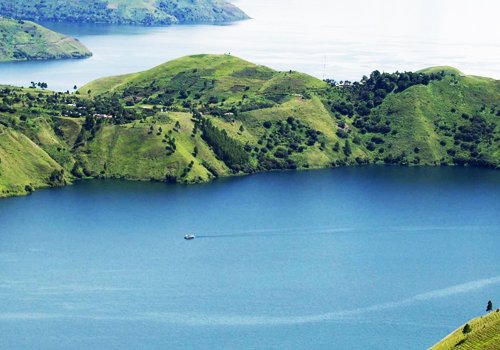Seventy-five thousand years ago, something tremendously terrible took place. Something so awe inspiring in its power that nothing has rivaled that event for all the time since. Something that may have even left an indelible mark on humanity itself. That event I am speaking of is the eruption of Toba of Indonesia, the greatest volcanic eruption, no explosion, that has happened in the last 100,000 years.

Today Toba is a lake. Something an even bigger version of Crater Lake in Oregon, USA. Today, Lake Toba is 100 km long and 30 km wide. Crater Lake is a mere 1.2 km in diameter. Lake Toba is the remains of the great eruption and the former volcano.

Toba 76,000 years ago was a great volcano, towering above the Indonesian archipelago, it would explode within a thousand years to produce an explosion at least 100 times as big as the Tambora eruption. It spewed ash and rock in such a large volume, the estimates vary from 2,000 to 3,000 cubic kilometers. It has been modeled to have dumped enough ash into the skies that it caused a nuclear winter like scenario. In 1816, Mount Tambora's eruption caused the Year Without a Summer. Toba's eruption was far, far larger.
And that, my friends, is the source of the controversy.

Geneticists looking at people have found that between 40,000 to 70,000 years ago, there was a genetic bottleneck for people. The entire population of people from whom we are descended appears to have constricted to a group of between 4,000 to 10,000 individuals. This means that people, for all our diversity, are actually very, very closely related, genetically speaking.
In 1993, Anne Gibbons, a popular science writer who specializes in paleoanthropology, linked these two events. The timing, she noted, was interesting. The potential for a 100x Tambora explosion to have caused a population crash amongst humans seemed like a very strong possibility. She presented the idea and others have since been trying to prove or disprove the hypothesis.
Right now, the science appears to be leaning against the Toba eruption from being the cause for the bottleneck. The evidence from South Africa shows there was little disturbance among the people living there. Likewise, evidence from India show stone tools immediately above and below the ash from the eruption. However, it should be noted, science is a process and what is believed to be the case today, may be proven tomorrow. It is NOT truth, but a way of understanding the world.

Even if the Toba eruption was not the cause of the genetic bottleneck, Toba as a volcano is actually just dormant, rather than dead or, at they say in the field, extinct. The island of Samosir in Lake Toba is actually growing. Someday, whether it is tomorrow or thousands of years in the future, Toba will erupt again. This is likely to happen because it has happened multiple times: 1.2 million years ago, 700 thousand years ago, 500 thousand years ago and then what we discussed above at 75,000 years ago. The reason eruption keeps repeating is because the Australian continental plate is butting up against the Pacific plate as Australia moves north. The collision causes a very active geological zone, producing hot spots and a lot of volcanoes. This provides Toba with the fuel and engine to erupt with. And with Samosir island growing, that means some day the eruption will come.
It is not to say that Toba will erupt any time soon though. There are far, far more active volcanoes that Indonesians need to worry about, as recent events have indicated. However, when Toba does blow its top again, it will be far, far greater than anything we as humans have ever seen.
Nicely written, and you are correct, toba is indeed one of the largest supervolcano in the world eruption wise, being beaten only by yellowstone (probably). Samosir island is indeed growing, but as an Indonesian, as far as i know, the growth is quite slow so its still relatively safe for the people there and it's surrounding regions, hopefully it wont be active for a long-long time
Posted using Partiko Android
I lived atop the Valle Grande in New Mexico, a state in the US. It's a fairly big volcano that is also dormant. I had no worries it was going to go off. I suspect Toba has another 100,000 years before it blows its top again. There are far more active volcanoes in Indonesia to worry about than Toba.
Thank you for the compliment about the post.
You are always welcome to join us and get more recognition for your posts. You can find more information about geopolis here or join our Discord server.